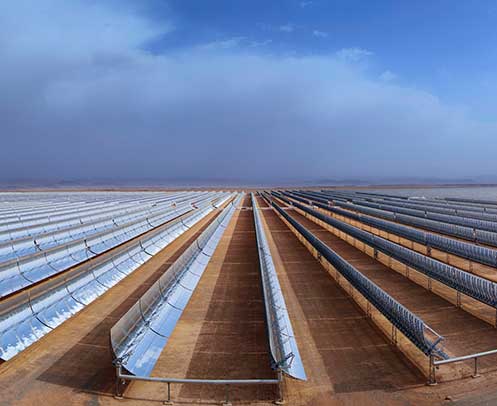
The falling cost of renewables offers an opportunity for Middle East and North African states to shift to capitalise on the energy transition – and even export “green molecules” to the world.
The Desertec initiative was launched in 2009 with the initial focus on exporting electricity to the north, over the Mediterranean and into Europe. This plan evolved into Desertec 2.0, focused on meeting domestic demand, is now on Desertec 3.0, which involves both domestic demand and exports to foreign markets.
“Exports started as a fixed idea for Desertec but now we see it as a consequence. If the region is able to produce at low cost levels it will by its very nature be able to export to world markets,” said Dii Desert Energy’s CEO Paul van Son to Energy Voice.
Algeria is expected to sign a memorandum of understanding (MoU) with Desertec in April, according to recent reports from Algiers.
The MENA region will become a major hydrogen producer, in addition to other synthetic products such as methanol and ammonia, because it will have the “cheapest energy resources in the world”, van Son continued. “Do the right thing locally and markets will automatically evolve to exports just as oil and LNG is sent around the world.”
Desertec is intended to gather industry and governments to work on renewable electrification plans. The original plan saw a number of shareholders jump ship in 2014, although some of these have now returned as advisors.
The aim is to remove obstacles to development, van Son said, a task that has been made substantially easier by a reduction in costs.
The Noor Energy 1 project in Dubai, for instance, which combines 250 MW of photovoltaic and 700 MW of concentrated solar power (CSP) technologies, started up in January and will generate electricity at a levelised tariff of $0.073 per kWh, allowing it to compete with fossil fuel generation.
Similarly, EDF Renewables and Dubai’s Masdar won a tender for a 400 MW wind project in Saudi Arabia with a bid of $0.0213 per kWh.
Given falling costs, the opportunities of renewable power are becoming ever more attractive. “All other obstacles are easily removed. Who would invest money in a coal or gas plant if the cost of solar or wind is so low?” van Son continued. Historically, renewables have been criticised for lacking the flexibility to respond when, for instance, the wind does not blow or the sun does not shine.
This is becoming less of an issue, van Son said, with a two-part answer. The first part is to make demand more flexible, for example charging electric vehicles (EVs) during sunshine hours. The second part is improving storage options, such as hydrogen or through battery technology.
Dubai’s Noor Energy 1 project, for instance, gets around the problem of darkness by storing power in molten salt, allowing it to continue generating through the night.
Support for renewable plans starts from state funds or government-backed energy companies, the Dii executive continued.
Sovereign wealth funds (SWFs) have substantial cash resources and there has been a discussion about whether these should play a part in financing the energy transition. Uptake thus far has been slow, with less than 1% of assets from institutional investors and SWFs in clean energy, a speaker at Chatham House said in January.
A notable exception is Abu Dhabi’s Mubadala, which has invested significantly in greenfield clean energy projects at a significant scale. The SWFs of the MENA region remain in support of oil and gas projects, in contrast, but could finance regional infrastructure projects such as high voltage transmission lines and hydrogen pipelines.
Van Son picked out Morocco’s Masen as one company making progress in solar plans, but multilateral development banks are getting involved. As the sector matures, commercial banks are showing interest and there is also scope for merchant power projects.
